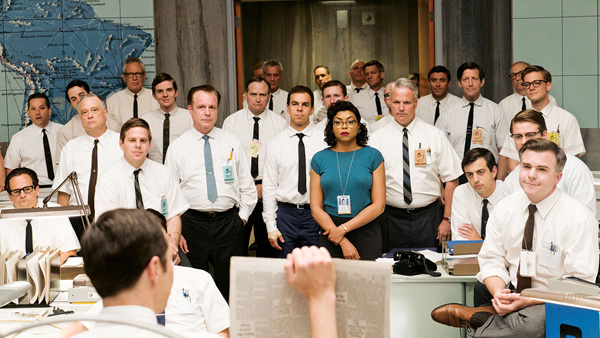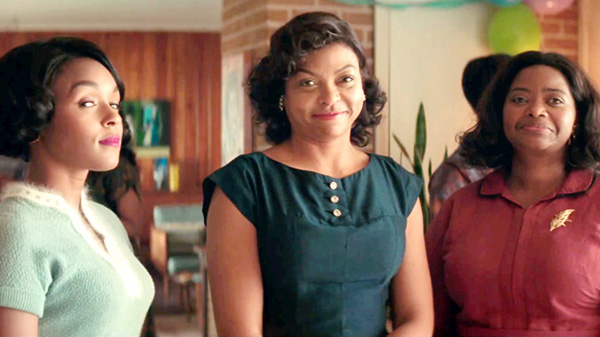|
Two recent films, Theodore Melfi’s Hidden Figures and Mike Mills’ 20th Century Women, depict women faced with
important life decisions in the second half of the previous century. Hidden Figures, the breakout hit of the winter season, is the story of three African-American
women, all mathematicians working at the National Aeronautics and Space Administration in 1961. 20th Century Women is also the story of three women—this time
living in Santa Barbara, Calif., in 1979—but this is where the resemblance between the two movies ends.
Taken by Melfi and Allison Schroeder from the book by Margot Lee Shetterly, Hidden Figures is the story of Katherine Goble Johnson
(Taraji P. Henson), Dorothy Vaughn (Octavia Spencer) and Mary Jackson (Janelle Monae), three women working in the segregated West Side Computer section of the NASA Langley Research
Center in Hampton, Va. We first see them stranded by the side of the road as Vaughn works under her old car to get it started again. A police car stops, an event that is
anything but welcome for black women in the segregated Virginia of 1961.
The cop demands to see their identifications. Seeing their NASA credentials, he says, “I didn’t know NASA employed
any…”
“Oh, there are a lot of women at NASA,” they reply.
The first scene of Hidden Figures sums up the rest of the action, as Johnson, Vaughn and Jackson struggle to gain recognition for their
obvious gifts in a patently racist system. Johnson is noticed first; falling behind the Soviet Union in the space race, the government is desperate to find a mathematician
with the ability in analytical geometry to get a manned capsule into orbit. Johnson turns out to be the one, and she is ordered to report to the office of Al Harrison (Kevin
Costner), project head for the space program.
 |
Nevertheless, Johnson initially has a horrible time in her first assignment. Her colleagues in the space program—all white and
almost all male—won’t allow her to drink from the same coffee pot as they do. Even worse, the only “colored” women’s
restroom in the complex is in Johnson’s former building, a half-mile away from her new office. A major motif in Hidden Figures is the humiliation Johnson suffers from having to run back and
forth between the office and the restroom while a fuming Harrison demands to know where she is.
Vaughn and Jackson don’t have an easy time themselves. Vaughn is the de facto supervisor of the West Side Computer
section, but Vivian Mitchell (Kirsten Dunst), Vaughn’s surly boss, won’t approve her promotion. Later, when NASA installs an
IBM computer, Vaughn must take furtive action to learn the skills necessary to operate it.
Jackson also faces obstacles in her quest to become a full-fledged engineer. A local high school offers the night courses
she needs, but the school is all-white.
To paraphrase the old adage, Johnson, Vaughn and Jackson had to be twice as good as everyone else to get ahead. Fortunately for
them, and for future generations, they were. Words such as “heartwarming,” “crowd-pleasing” and “inspirational” have
peppered the reviews of Hidden Figures, with good reason. Few movies have been so satisfying in presenting the rise of strong,
likable, brilliant women against daunting odds.
The screenplay is solid and Melfi’s direction is sure, but the real glory of Hidden Figures is its cast, particularly its three leads.
Henson’s Johnson is the film’s main character, and she persuades us fully of Johnson’s intelligence and passion. The
same is true of Spencer and Monae, and the most moving thing about Hidden Figures is the love and solidarity the three women
share. Vaughn and Jackson may feel pangs of disappointment as Johnson rises first in the NASA hierarchy. But their affection
for her, and their pleasure at seeing her success, precludes any jealousy or bitterness.
 |
The advancement of Johnson, Vaughn and Jackson is all the more amazing when you think about another notable film of the
past year, Jeff Nichols’ Loving, also set in Virginia circa 1960.At the same time that Johnson, Vaughn and Jackson fought
endemic racism to be recognized, literally, as rocket scientists, Mildred Loving fought endemic racism to be able to live in her
home state and stay married to the man she loved. Between Hidden Figures and Loving—along with another 2016 film, Barry Jenkins’ Moonlight—it’s hard to imagine movies more
pertinent to today’s political situation, or with messages more urgent to today’s audiences.
The white characters in 20th Century Women may seem trivial by comparison. However, their problems are indicative of a
major crossroads in American society, just when the Me Decade was crumbling into ruins and the horrors of HIV were waiting in the wings.
The loosely plotted film revolves around five people: Dorothea (Annette Bening), owner of a crumbling Victorian house in Santa
Barbara; her 15-year-old son Jamie (Lucas Jade Zumann); Abbie (Greta Gerwig), a punk-rocker who is a boarder in Dorothea’s
house; Julie (Elle Fanning), a 17-year-old neighbor; and William (Billy Crudup), a handyman who also boards in Dorothea’s house and sees to its endless renovations.
Dorothea is an engineering draughtswoman, which seems odd considering the imprecision of the rest of her life. When her car
catches fire—the type of thing that is likely to happen to her—her first instinct is to invite the fireman who puts out the fire to dinner.
In her mid-50s, Dorothea feels overwhelmed by both the changing culture and having a teenage son. She asks Abbie and
Julie to help her with Jamie. “You get to see him out in the world as a person,” she tells Abbie. “I never will.”
Unfortunately, Abbie and Julie are not the best choices Dorothea could have made for helping raise Jamie. Abbie, whose
past is sadder than she lets on, overloads Jamie with books on feminism that merely confuse him (and which earn him a beatdown at the local skateboard park when he quotes from
them). Julie, in rebellion from her therapist mother, regularly climbs through Jamie’s window to share his bed with him, on a
strictly platonic basis. Dorothea, of course, knows none of this. William, meanwhile, is not much help either in repairing the
house or in dealing with Jamie, who feels no bond with him.
20th Century Women is essentially a snapshot in time; as Mills’
anecdotal screenplay tells us, Julie, Abbie and William were all thrown accidentally into Dorothea and Jamie’s orbit. Just as Beginners, Mills’ previous film, was a semi-autobiographical
movie about Mills’ father, so 20th Century Women is a semi-autobiographical movie about his mother. Mills is more or less Oliver in Beginners, and more or less Jamie in 20th Century
Women.
Both films share a fluid storyline that moves back and forth in time, but they have important differences as well. Beginners is in
three interwoven sections, the most interesting of which by far is the story of how Oliver’s father Hal (Christopher Plummer) came out as gay in his old age. 20th Century Women is much more of a
piece than Beginners, but it lacks high points; if there’s a movie that can be accused of simmering without ever coming to a boil,
it’s this one. On the other hand, simmering without boiling is thoroughly appropriate to these characters, who live in a
perpetual state of quandary with their highly personal problems.
It is the actors who keep us interested in 20th Century Women—especially Bening, who gives a masterful performance
as a woman who has lived her entire life on shifting sand. The clear-cut goals of a Katherine Johnson were simply never there for her. But though 20th Century Women seems wispy in
comparison with Hidden Figures, it lingers in the mind. Whereas Hidden Figures is about strong, admirable women encountering obstacles and conquering them, 20th Century
Women is about people finding it difficult to live in the
universe. There is plenty of room for both movies in your viewing schedule.
|